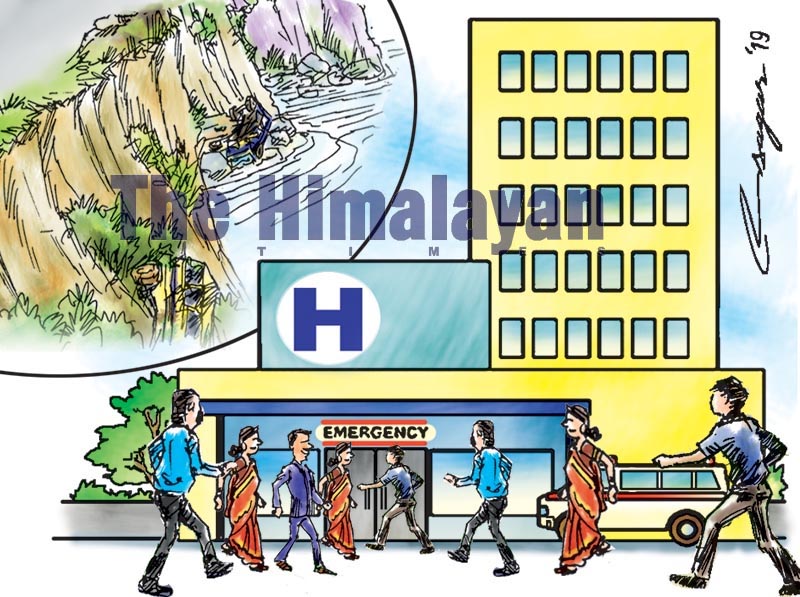National trauma care system: Need of the day
A trauma care system is an organised way to deal with trauma victims. The nearest hospital may not be the best option for a trauma victim because he or she needs a different type of care and treatment than those given to other ill patients
World Trauma Day is marked on October 17 every year around the world. It may sound new to Nepal, but the issue is of equal importance to this country as is elsewhere, with the ever-increasing number of accidents and injuries, resulting in deaths and disabilities, and the need to prevent them.
It all began in 2011 in New Delhi, with The Trauma Society of South Africa, which has the world’s highest road mortality rate of 40 deaths per day. The purpose was to set a day aside to consider the impact, prevention and treatment of traumatic injuries and deaths.
According to World Health Organisation (WHO), trauma is a major cause of death and disability across the world. WHO research has shown that at least 50 per cent of road crash deaths in developing countries can be prevented with effective intervention.
Trauma is a Greek word meaning bodily injury. Injuries can occur from road crashes, falls, burns and interpersonal violence. But road traffic accidents, or crashes, are the leading cause of trauma in Nepal, making them the 5th highest cause of death and first cause of physical disability. Approximately seven persons die and several others are injured on average in road crashes every day in Nepal.
Importantly, these victims are from an economically productive age group of 20 to 40 years. This can cost Nepal great economic loss of 1-3 per cent of its GDP. Despite these facts, apart from some sporadic activities, trauma has not been addressed adequately. Establishment of a national trauma care system can be an effective intervention tool for our country:
A trauma care system is an organised way to deal with trauma victims. This gets the right patient to the right hospital and at the right time. The nearest hospital may not be the best option for a trauma victim because he or she needs a different type of care and treatment than those given to other ill patients.
It is known that 20 per cent of road crash victims die on the spot from unsalvageable serious injuries like brain stem trauma. Another 20 per cent die in hospital from sepsis and multiple organ failure despite treatment. It is the remaining 60 per cent who can be saved by putting a trauma care system in place.
This can be organised by putting together already available health care resources appropriate for trauma care. We must have a national trauma care system to begin with and immediately.
Similarly, later we can have a regional trauma care system and even a local trauma care system at the regional level and local level in compliance with the present federal system of governance.
A trauma care system has three components: Pre-hospital care, hospital care and post-hospital care.
Pre-hospital care is the treatment given to a crash victim before reaching hospital. It comprises of rescue of the victim from the site of the accident either by scoop and run method or treat to stabilise and transfer method. On the spot treatment or first aid can be given by any first responder or a paramedic after training. Later, transfer of the victim from the crash site to a hospital should be safe.
Safe transportation of the victim is assured by an ambulance manned by emergency medical technicians who are paramedics trained in emergency trauma care and equipped with life support drugs and machines. Any other vehicle without these facilities, if used to transfer the victim in a hurry, does increase the risk of death of seriously injured victims by 60 per cent.
Hospitals dealing with acute trauma must be well equipped, manned by a trauma trained team and prepared to treat victims on arrival. Even CPR performed on trauma victims is different than that of a typical CPR. Multi-specialty team treatment and damage control surgery are unique features of such a facility that greatly increases the victim’s survival chance. Such a facility can be part of the existing hospital or a single hospital dedicated to trauma.
A trauma centre is a specialised hospital dedicated to treating trauma victims. A heart hospital, TB hospital and a maternity hospital are examples of specialised hospitals. A trauma centre is distinguished by the presence of a trauma team of specialists round the clock to attend to the trauma victims unlike general hospitals where treatment is primarily by general doctors. It is equipped with necessary lifesaving and sustaining equipment besides a total body scanner to scan from head to toe in a few minutes.
Trauma centres are designated as level I, II, III or IV in the order of descending status depending upon availability of specialists, equipment and supporting facilities. According to WHO, for every 1 million people, there should be one level I trauma centre. Ironically Nepal, with 28 million people, has just one in Kathmandu, which was built, equipped and handed over by the Indian government to Nepal in 2015. This National Trauma Centre, the first of its kind in Nepal, unfortunately, is functioning just like any other general hospital. Local politics aside, lack of awareness of its importance may be a strong reason.
Post-hospital care is aimed at rehabilitation of the victims medically, psychologically, socio-economically after the hospital treatment of the victims.
Dr Bajracharya is retd founder executive director, National Trauma Centre






